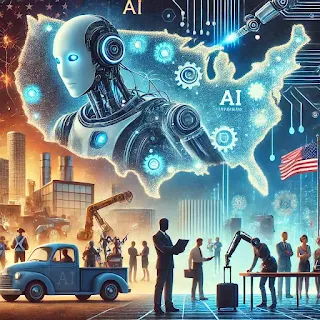Artificial Intelligence's Impact on the U.S. Labor Market: A Comprehensive Analysis
- Get link
- X
- Other Apps
Artificial Intelligence's Impact on the U.S. Labor Market: A Comprehensive Analysis
Introduction
Artificial Intelligence (AI) has rapidly evolved from a niche technology to a transformative force across various industries. In the United States, AI's integration into the labor market has sparked discussions about its potential to reshape employment landscapes, influence job creation and displacement, and redefine the skills required for the future workforce. This article delves into the multifaceted impact of AI on the U.S. labor market, examining current trends, potential benefits, challenges, and strategies to navigate this evolving terrain.
1. The Current State of AI in the U.S. Labor Market
AI technologies, encompassing machine learning, natural language processing, and robotics, have permeated numerous sectors, including healthcare, finance, manufacturing, and retail. Businesses leverage AI to enhance efficiency, reduce operational costs, and drive innovation. A survey by the Federal Reserve Bank of New York revealed that approximately one-third of service firms plan to implement AI within the next six months, indicating a growing trend toward AI adoption.
2. Job Displacement and Creation
AI-Powered Automation in the U.S. Labor Market
2.1. Potential for Job Displacement
The automation capabilities of AI pose a risk to certain job categories, particularly those involving routine and repetitive tasks. A study by the Organisation for Economic Co-operation and Development (OECD) estimated that 9% of jobs in the U.S. are at high risk of automation. Occupations such as data entry clerks, telemarketers, and assembly line workers are among those vulnerable to AI-driven automation.
2.2. Opportunities for Job Creation
Conversely, AI is anticipated to generate new job opportunities, especially in fields requiring advanced technical skills. Roles such as AI specialists, data scientists, and robotics engineers are in increasing demand. Additionally, AI can augment existing jobs by handling mundane tasks, allowing workers to focus on more complex and creative aspects of their roles. The International Monetary Fund (IMF) suggests that AI can boost productivity and create new tasks and jobs, thereby increasing labor demand in non-automated tasks.
3. Impact Across Different Sectors
3.1. Healthcare
Infographic of AI Impact on Different Job Sectors
In healthcare, AI assists in diagnostics, personalized treatment plans, and administrative tasks. AI algorithms analyze medical images to detect diseases at early stages, improving patient outcomes. The integration of AI in healthcare is creating roles in health informatics and bioinformatics, blending medical knowledge with data analysis skills.
3.2. Manufacturing
Manufacturing has seen significant AI adoption through robotics and predictive maintenance. While some manual labor roles may decline, there is a growing need for workers skilled in operating and maintaining AI-driven machinery. This shift necessitates reskilling programs to prepare the workforce for advanced manufacturing environments.
3.3. Finance
The finance sector utilizes AI for fraud detection, risk assessment, and customer service through chatbots. Financial analysts now employ AI tools to process large datasets, enabling more informed decision-making. This trend underscores the importance of combining financial expertise with proficiency in AI applications.
4. Regional Variations in AI Impact
The effect of AI on employment varies across different regions in the U.S., influenced by factors such as industry composition, workforce skill levels, and economic conditions. Regions with economies heavily reliant on manufacturing or routine-based industries may experience higher rates of job displacement due to automation. Conversely, areas with a strong presence of technology and service-based industries might see job growth driven by AI advancements.
5. Addressing the Skills Gap
The rapid integration of AI into the workplace has highlighted a significant skills gap. Many workers lack the necessary technical competencies to thrive in an AI-enhanced environment. To bridge this gap, educational institutions and employers must collaborate to develop training programs focused on AI literacy, coding, data analysis, and other relevant skills. Emphasizing lifelong learning will be crucial to ensure the workforce remains adaptable to technological changes.
6. Policy Implications and Recommendations
Policymakers play a vital role in facilitating a smooth transition into an AI-influenced labor market. Recommendations include:
Implementing Reskilling Initiatives: Government-funded programs can provide workers with opportunities to acquire new skills aligned with market demands.
Encouraging Ethical AI Practices: Establishing guidelines to ensure AI deployment is fair, transparent, and respects workers' rights.
Adjusting Tax Policies: Revising tax structures to incentivize companies to invest in human labor alongside AI technologies, as suggested by researchers advocating for higher tax rates on capital compared to labor.
7. The Future Outlook
Future of AI-Driven Jobs in America
Looking ahead, AI is poised to continue its expansion across various sectors, further influencing the U.S. labor market. While challenges such as job displacement and the skills gap persist, proactive measures in education, policy, and business practices can harness AI's potential to enhance productivity and create new employment opportunities. Continuous monitoring of AI's impact on employment and adaptive strategies will be essential to maximize benefits and mitigate adverse effects.
Conclusion
Artificial Intelligence is undeniably reshaping the U.S. labor market, presenting both opportunities and challenges. By understanding the dynamics of AI integration and implementing strategic initiatives, stakeholders can navigate this transformation effectively. Emphasizing reskilling, ethical practices, and supportive policies will be key to ensuring that AI serves as a catalyst for positive change in the American workforce.
References
Federal Reserve Bank of New York. "AI and the Labor Market: Will Firms Hire, Fire, or Retrain?" https://libertystreeteconomics.newyorkfed.org/2024/09/ai-and-the-labor-market-will-firms-hire-fire-or-retrain/
Organisation for Economic Co-operation and Development (OECD). "Automation, skills use and training." https://www.oecd.org/employment/automation-skills-and-training-2016.pdf
International Monetary Fund (IMF). "The Labor Market Impact of Artificial Intelligence: Evidence from US." https://www.elibrary.imf.org/view/journals/001/2024/199/article-A001-en.xml
Chicago Booth Review. "A.I. Is Going to Disrupt the Labor Market. It Doesn't Have to Destroy It." https://www.chicagobooth.edu/review/ai-is-going-disrupt-labor-market-it-doesnt-have-destroy-it
Liberty Street Economics. "AI and the Labor Market: Will Firms Hire, Fire, or Retrain?" [https://libertystreeteconomics.newyorkfed.org/2024/09/ai-and-the-labor-market-will-firms-hire-fire-or-retrain/](https://libertystreeteconomics.newyorkfed.org/2024/09/ai-and-the-labor
- Get link
- X
- Other Apps




Comments
Post a Comment